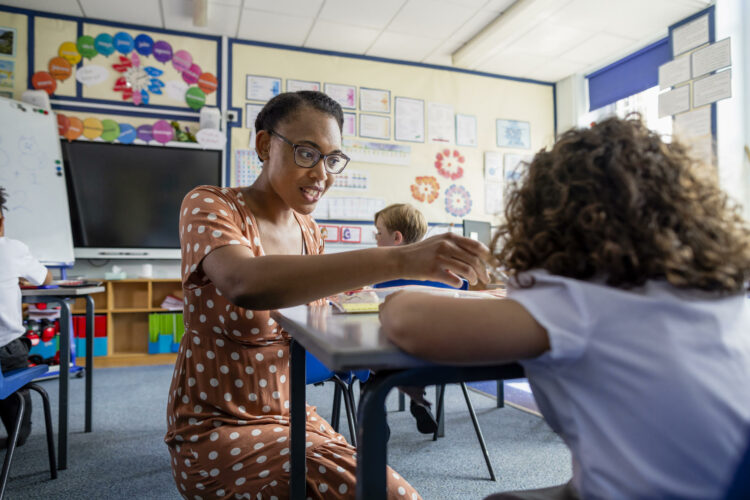As a teacher, you know that having a practice-based coach on your side to share insights and guidance can be invaluable. How can you now embed those insights into your teaching practice and take it to the next level?
Setting goals during your coaching sessions is important, but you may be wondering what kind of goals to set and how to formulate those goals for maximum success.
In this guide, we’ll discuss why goal setting is an important aspect of practice-based coaching, what those goals should look like, and how you can set yourself up to achieve those goals with a concrete action plan.
Table of Contents
- Goal Setting Is a Primary Foundation of Practice-Based Coaching
- When Should Goal Setting Take Place in Practice-Based Coaching?
- Who Is Responsible for Setting Goals—The Coach or The Teacher?
- 4 Types of Goals That May Be Set in Practice-Based Coaching (With Examples)
- 3 Requirements of Effective Practice-Based Coaching Goal Setting
- Achieve Goals With a Practice-Based Coaching Action Plan
- Set Effective Practice-Based Coaching Goals With TORSH Talent
Goal Setting Is a Primary Foundation of Practice-Based Coaching
Practice-based coaching has many benefits, but those benefits are only realized when goal-setting is the priority of both the coach and the teacher.
What is goal-setting in the context of coaching?
Goal setting happens when both the teacher and coach discuss particular teaching practices and then decide which aspect of each practice should be the focus of any individual coaching session.
Focusing on multiple aspects of a teaching practice all at once can be overwhelming and impractical. When goals are broken down into a series of discrete steps, the coach and the teacher both benefit. The teacher knows precisely where to focus their efforts for improvement, and the coach can target how they will guide the educator without getting distracted.
Some goals around teaching practices that teachers and coaches may set include:
- Classroom rules
- Using visual schedules
- Active student engagement
- Interaction during learning activities
- Planning activities and lessons
- Peer interactions
- Organization and time management
Why Is Goal Setting So Important?
Desmond Tutu wisely said, “There is only one way to eat an elephant: a bite at a time.” He probably wasn’t thinking about practice-based goal setting when he uttered those words, but they are nevertheless relevant.
During any given day, a teacher is responsible for various teaching tasks and student interactions. Without clear goals and priorities, the teacher may not know what professional growth objectives to tackle first.
But when goals are identified, it allows the teacher to isolate their attention on a particular strategy and focus their efforts on improvement.
Goal setting:
- Identifies specific student behaviors that may need attention
- Helps to guide interactions with a coach
- Makes the coaching process manageable and achievable
- Showcases successes
- Gives guidance in planning for future goals
- Supports student learning and better outcomes
When Should Goal Setting Take Place in Practice-Based Coaching?
Some groundwork needs to be laid before goal setting can be effective; first, it’s wise to determine priorities for your practice-based coaching collaboration.
Priorities are typically determined as a result of a performance assessment (also known as a needs assessment), which follows a coaching observation.
After observing a teacher, a coach may identify issues such as:
- Too much time to transition between activities
- Student engagement is low during read-aloud time
- There is negative classroom behavior occurring during “down time”
- Some students lack enough challenge and are bored, while others are falling behind and are becoming frustrated
Armed with this information, the coach and teacher are better equipped to collaborate on which goals to set for future practice-based coaching.
Without this preliminary step, any goals set by the coach would merely be a shot in the dark. After adequate observation, the coach can pinpoint areas for improvement and take the lead in identifying specific goals to work toward. It’s important to point out that the coach may also observe areas in which the teacher is excelling—these should also be noted and celebrated! These areas of success can also inform your goal planning; highlighting what works can help illuminate how to fix what isn’t working.
Following a classroom observation, a coach and teacher can work together to make a needs assessment that includes methods such as:
- Implementation checklists
- Teacher self-assessment
- Assessment rating systems like CLASS and ECERS
- Other needs assessment tools
The Roles of Observation and Performance Assessment in Goal Setting
Before a teacher can know what areas of growth they need to work on in their teaching practice, their strengths and weaknesses need to be identified. Then, goal setting can be more productive, focused, and successful.
Of course, teachers assess themselves every day. They know when a lesson really hit the mark, or when a particular teaching strategy failed to gel. These self-assessments may happen internally and on the fly throughout the day. But with the time constraints of a busy, active classroom, a teacher’s ability to more formally assess themselves is limited.
This is where observation and performance assessment is helpful.
A coach can observe a classroom and gain a clear outsider’s perspective that a teacher would find quite difficult to do on their own. Feedback from the coach can be invaluable in determining which practices need the most attention, and what goals to set to address them.
Video observation is even more powerful because this allows the teacher and coach the opportunity to look at the footage together. They can stop the video at various points to discuss areas of need in “real-time,” and then collaborate on setting goals to bring about growth and improvement in those areas.
TORSH Talent provides an interactive and collaborative platform that puts everything you need for video-based practice-based coaching at your fingertips.
Who Is Responsible for Setting Goals—The Coach or the Teacher?
After the coach and teacher discuss the observation assessment, the teacher has the information they need to choose which aspect of their teaching practice they’d like to focus on.
After collaborating with the coach, the teacher then formulates goals that will guide them to the growth and improvement they desire.
Though the coach is available to help the teacher examine their goals to make sure they are attainable, it makes perfect sense for the teacher to be the one who sets the goals.
Setting personal goals gives the teacher ownership and vested interest that will stimulate motivation and dedication—even when improvement is slow or reaching the goal seems daunting. The same is true when educators guide students to set their own learning goals!
Setting goals after the performance assessment allows the teacher to make educated decisions about goals, rather than trying to work on everything at once.
4 Types of Goals That May Be Set in Practice-Based Coaching (With Examples)
Goals can be broken down into different types to provide more intentionality to the teaching and coaching process. Goals should be specific.
Goals that teachers may set through practice-based coaching may fall into four categories:
- To learn more about a practice with which they aren’t very familiar
- To engage more often in a practice that they have participated in before
- To become more skilled at a particular practice
- To discover new ways to perform the practice differently
We’ll dive deeper into each of these types of goals and look at some examples of how to practice them in the classroom.
#1: To Learn More About a Practice
Perhaps you’ve heard of a particular practice that your teacher colleagues use with success, but it’s one that you haven’t tried yourself. For example, you’ve heard that other teachers are using “Sound Walls” in their classrooms to support The Science of Reading. Thus far, you don’t really know their purpose or how to implement them.
Setting a goal in this way would involve:
- Learning more about the new practice through research or speaking with colleagues
- Thinking of various ways you can adapt the practice to your unique classroom
- Experimenting with the practice in your classroom
- Assessing how the practice is working and adapting as needed
As another example, let’s say the particular area you want to focus on is student engagement —you want to provide activities that keep the students hooked and interested, especially “fast finishers” who complete their work before the majority of their classmates.
Considering this scenario, this first goal type may look something like this:
I will research several methods of maintaining student engagement and pick three new ways to provide activities for children who finish tasks early. In doing so, I’ll consider the particular needs of my students and what fuels their excitement.
#2: To Engage in The Practice More Often
Another option is to choose a practice that you use occasionally or only when doing a specific classroom activity. Then, set a goal to bring that practice in more often, applying it to different classroom exercises.
If the teaching practice you want to focus on has to do with an orderly classroom and students following the rules throughout the entire school day, a goal of this type may be:
I will post reminders of the rules throughout the room, at centers, and during circle time, and will review them aloud in the morning, before lunch, and before recess.
#3: To Become More Skilled at the Practice
This type of goal has to do with a practice you are familiar with, but you’d like to become more effective in how you use it.
Let’s say you’d like to focus on effective scheduling so that children are aware of the day’s routine. Setting a goal that allows you to use a current practice with greater efficiency may be something like:
Rather than simply posting the schedule on the bulletin board, I will practice using musical or sound cues to signal when it’s time to switch classes or move to the next activity.
#4: To Perform The Practice Differently
Maybe you’ve used a practice successfully but wonder if using it differently would produce better results.
If you want to improve how you integrate subjects and activities, changing things up may happen with a goal like this:
For independent reading time, I will choose books related to our science and history studies for the week that will help build students’ background knowledge at the same time as building their reading comprehension and fluency.
3 Requirements of Effective Practice-Based Coaching Goal Setting
Setting goals is necessary for improving teacher practice, but setting the right goals is key to reaching those goals with success and confidence.
Setting vague, unmeasurable, or unrealistic goals is not only unhelpful but can also be discouraging and counterproductive.
Instead, when setting practice-based coaching goals, make sure they are:
- Specific
- Observable
- Measurable
- Achievable
#1: Specific
Compare these two goals:
- I will spend more time each day reiterating classroom expectations.
- I will discuss classroom expectations at the beginning of the day, before lunch, and after returning from recess.
The second goal here gives the teacher a clearer way to proceed, along with time-oriented checkpoints. Goals that are too general are difficult to measure, leaving you wondering if you’ve actually attained them or made any improvement.
Specific practice-based coaching goals should define:
- What the teacher aims to do
- When the teacher will do it
- With whom the teacher will perform the activity
#2: Observable and Measurable
Practice-based coaching goals should also be ones that can be observed by the coach.
Observation allows the coach to:
- Assess progress
- Share further insights
- Celebrate successes
Goals should be measurable, so you can know when a goal has been met.
Requirement #1 (“goals should be specific”) helps here because specific goals are measurable by nature. Goals that are too general are hard to measure.
For instance, let’s say your goal is, “I will provide more time for independent reading.” How can you know if you’ve met that goal? How much is “more”?
A better goal that is measurable would be, “I will implement independent reading time for ten minutes before lunch and for ten minutes after returning from recess.”
#3: Achievable
Goals should also be realistic.
We may be tempted at times to set lofty goals that aren’t attainable. When we fail to meet these ambitious goals, we can feel defeated and may give up.
Instead, with the help of the coach, teachers can set realistic goals—not too high or too low—that will improve teacher practice and student engagement in the long run.
To make goals achievable, it’s important to assign a specific and realistic time frame to reach the goal. If a goal is a stretch, perhaps a teacher should break that goal into smaller pieces and assign various dates to reach individual goals along the way.
Goals without an end date are not only unmotivating but can also be discouraging.
Achieve Goals With a Practice-Based Coaching Action Plan
Once a performance assessment has taken place, observations have been discussed, and goals have been set, it’s now time to develop a plan that will move toward the achievement of the goal.
Practice-based coaching action plans should include the following:
- A clearly-stated goal
- A statement detailing how you know the goal has been achieved
- Necessary resources to support the pursuit of the goal
- A timeframe for completion
- Specific action steps that:
- Are enumerated
- Outline the coach’s involvement
Set Effective Practice-Based Coaching Goals With TORSH Talent
To ensure successful professional development for educators, TORSH Talent provides a platform with an array of resources that teachers and coaches can implement together to improve teacher practice and student experience.
Our platform provides all the tools for:
- Video-based observation
- Feedback
- Synchronous and asynchronous collaboration
- Coaching effectiveness
- Insights based on data and built-in reports
We don’t set practice-based coaching goals for you. We give you the resources you need to do it effectively and efficiently.
See what others are saying about TORSH Talent and request a demo today.




